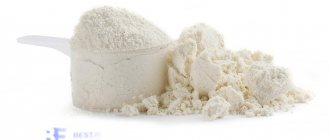01/01/2017 Food
Whey protein is a supplement used by athletes, bodybuilders and fitness enthusiasts for muscle recovery, growth, and overall health.
Whey Protein
(protein)
is
a concentrated mixture of globular proteins obtained from whey. In this case, whey should be understood as a liquid composition that is formed during curdling and is a by-product during the manufacture of cheese.
Whey Protein Review
In this article you will learn:
- What is whey protein and how is it produced.
- Who can benefit from taking this supplement?
- How to choose the right whey protein supplement.
- How much whey protein to take and when.
- Which whey protein is best?
What is whey protein?
Whey protein is a term used to describe a group of milk proteins obtained from the whey that remains during the curdling process of milk during cheese production. Most people think of whey protein as just a bunch of amino acids, but it contains more than just those.
For example, a protein mixture typically contains about 65% beta-lactoglobulin, 25% alpha-lactalbumin, 8% bovine serum albumin and small amounts of immunoglobulins, lactose and fats.
How is whey protein made?
Whey protein is made directly from milk or even cheese, but almost most brands of whey protein are made from milk. It’s not hard to guess what whey protein is made from, the main question is how.
First, the whey is separated from the milk by filtration, which leaves a liquid whey product. Next, it goes through a process of high-temperature short-term pasteurization.
The serum is heated to the required temperature minimum of 72 C for 15 seconds. Milk is pasteurized to kill any pathogens that may be present in it.
The next step is to separate the proteins from the liquid whey. This is achieved by ion exchange methods or mechanical filtration.
Ion exchange often requires the use of acids (such as hydrochloric acid) or alkalis (such as sodium hydroxide), which may result in some denaturation of proteins
Although chemical ion exchange is cheaper and involves a large number of amino acids, the downside of this process is the loss of some important compounds in the whey product, such as lactoferrin and large amounts of immunoglobulins.
Mechanical filtration, better known as cross filtration, is a technological process that results in a better product. However, this method is expensive and time-consuming.
Key factors in whey protein production are the type and size of the filter, as well as the number of filtrations. The thinner the filter and the greater the number of filtrations, the purer and better the product. With each filtration, the amount of lactose, fat and other small impurities in the protein product is reduced.
The type of filter and the number of filtration is the main difference in the production of different types of whey protein (isolate and concentrate mainly).
How to take whey protein to gain muscle mass?
The usual recommended dose is 1-2 scoops (approximately 25-50 g) per day, preferably after training.
The dose depends on the total amount of protein consumed per day.
If the diet contains enough natural protein products, then the benefits of taking any types of sports proteins, including whey, are very doubtful.
Scientific research confirms this. In one study, supplementing with protein on a complete protein diet for 12 weeks did not make any difference in changes in muscle mass 33.
Scientific research suggests that whey protein is particularly effective in building muscle mass when consumed immediately before, after, or during exercise, but the greatest effect is seen when consumed immediately after exercise 21-24.
At the same time, a meta-analysis of numerous studies on the effect of the timing of protein intake on muscle mass gain and muscle strength increases shows that the total amount of protein during the day is important for muscle growth , and not the specific point in time when it is drunk: i.e. e. it makes no difference whether you take Protein 25 before, after or during training.
Although whey protein is most often recommended to be taken before, during or after a workout, scientific research shows that it is the total amount of protein consumed throughout the day that is important for muscle growth, not the specific time of intake (before, after, during training )
We recommend : Is it possible to eat eggs while losing weight? Which is better: raw, boiled or fried?
Note
On many whey protein packages, manufacturers write “100% Whey” in capital letters as a marketing ploy.
Such an inscription does not carry any semantic load: there is no doubt that in the production of such protein, manufacturers used only whey.
The purpose of such an inscription is to produce a purely psychological effect: after all, we like to pay money only for what is 100% what we want to buy.
At the same time, it would be WRONG to interpret such a note as an indication of “the best quality protein.”
Types of Whey Protein
There are three main commercially available types of whey protein: whey protein isolate, whey protein concentrate and whey protein hydrolysates.
Whey protein isolate
Whey protein isolate is considered the purest form of whey protein. It contains 90-95% whey protein, very small amounts of fat (0.5-1.0%) and lactose (0.5-1.0%). This makes whey protein isolate a good source of protein for people who are lactose intolerant or have problems digesting lactose.
It's worth noting that whey protein isolate often lacks many of the other beneficial components of whey, including immunoglobulins and other small molecules that have health benefits. So when choosing a whey protein isolate, keep in mind that it may be missing a few magic ingredients.
Whey Protein Concentrate
Whey protein concentrate contains a smaller amount of protein, which is usually in the range of 25-89%, the most commonly found concentrate on sale is 80% protein. It also contains about 4-8% lactose, fat and other minerals.
This type of whey is found in protein bars and other foods.
Whey protein hydrolysates
Whey protein hydrolysates, or hydrolyzed whey, are whey protein that has been treated with special enzymes that break down long chains of proteins into shorter ones. This process makes whey protein easily digestible for the body and reduces the likelihood of allergic reactions and digestive disorders. This type of whey protein is often included in infant formula, sports nutrition and medical products.
Varieties
Whey protein is the name of a product group. These types of whey protein are the most common on the market:
- Classic protein. The ratio of pure protein is about 70%. Cheapest source. It is not a commercial success due to weak advertising.
- Whey prot. The ratio of pure protein is about 85%. It is actively advertised by manufacturers as the coolest, most sophisticated and effective - because of this, it is more expensive than KSB and classic. Sold only in small packaging. Effective, but expensive.
- KSB prot. The ratio of pure protein is about 80%. Cheapest source. Commercially unsuccessful due to weak advertising.
- Isolate. The ratio of pure protein is about 90%. Unjustified consumption of protein. Needed only for bodybuilders-chemists who clearly calculate the fermentation and intake of a pure product, monitoring the calorie intake down to 1% of consumption.
- In complexes. The ratio of pure protein is about 50%. Used in gainers and complex proteins. Efficiency is low.
What are the benefits of whey protein?
Whey protein supplements have recently become popular among athletes to improve athletic performance. Whey protein is a popular dietary supplement; whey protein is good for gaining muscle mass and strength; it contains essential and biologically valuable amino acids and branched-chain amino acids.
In addition, using whey protein for weight loss, this type of protein reduces oxidative stress by increasing the production of endogenous glutathione, as well as problems with the digestive system that periodically occur during intense physical activity.
I also want to remind everyone that natural sources of whey protein may be superior to whey protein supplements in terms of holistic nutritional value.
Increases strength and lean body mass
Most sporting events depend on the strength performance of the muscles; the more strength in the muscles, the higher the performance and performance of the athlete. Since strength is the product of mass and acceleration (F = M * A), increasing muscle mass is the most common way in which athletes seek to increase strength performance.
Skeletal muscle hypertrophy requires proper training, resistance exercise, and a nutritional state in which muscle protein synthesis exceeds muscle protein breakdown.
One of the main concepts in the skeletal muscle hypertrophy literature is that of net protein balance. Net protein balance is determined by the difference between muscle protein synthesis and its breakdown. Thus, if synthesis is greater than breakdown, skeletal muscle hypertrophy occurs.
One of the most important factors influencing protein synthesis and breakdown is the presence of amino acids. Whey protein supplements are a source of amino acids of high biological value and are used to increase muscle mass and strength.
There has been a huge amount of research done into the effectiveness of whey supplements. Their results are not entirely clear; however, most of the evidence collected suggests that whey protein does help build muscle mass.
In addition, researchers have recently shown that whey protein components regulate cell signaling pathways, namely the target of rapamycin, responsible for muscle protein synthesis and muscle hypertrophy.
Whey Protein and Glutathione
Oxidative stress is an imbalance between antioxidant defense systems and the production of reactive oxygen species. Oxygen demand during strenuous exercise can increase up to 100 times that at rest, which increases the production of free radicals, leading to oxidative stress.
Although research data is not clear, there is direct evidence that after intense training, the number of free radicals increases rapidly, and along with it, cell damage.
Athletes are at much higher risk of developing oxidative stress than the average person. The high levels of reactive oxygen species produced during strenuous exercise must be reduced by the body's endogenous antioxidant system in order to maintain oxidative balance.
Glutathione, the most common and important antioxidant, is a tripeptide synthesized from the amino acids L-cysteine, L-glutamic acid, and glycine. It is the most important redox couple and plays a critical role in antioxidant defense, nutrient metabolism, and regulation of pathways essential for overall body homeostasis.
In addition, glutathione acts as a regulatory compound in the activation of the circulating agents of the immune system, lymphocytes.
Glutathione is an important compound for maintaining overall health, and its deficiency can indicate various pathological conditions in the body, such as cancer, neurodegenerative diseases, cystic fibrosis, HIV and aging. Glutathione is very popular among athletes, as it is among them that its levels undergo significant fluctuations as a result of nutritional deficiencies, grueling training, and oxidative stress.
The athlete's body is subjected to high physiological stress. Glutathione plays an important role in maintaining normal redox processes during exercise.
This leads to the conclusion that it is necessary to maintain and even increase glutathione levels in athletes. Research has shown that the amino acid cysteine is a rate-limiting factor in glutathione synthesis. Thus, protein sources rich in cysteine should be included in the diet, which will effectively affect the rate of glutathione resynthesis.
However, supplements with free cysteine are not recommended, as it quickly oxidizes and becomes toxic. But natural sources of cysteine, present in food in the form of cystine (two cysteines linked by a disulfide bond), are more stable than free cysteine, and most importantly, they are well absorbed. Whey protein supplements, both isolates and concentrates, are protein sources that are rich in cysteine and transport it into cells through normal metabolic pathways.
Supplementing whey protein with the right amount of cysteine allows cells to replenish and synthesize glutathione without side effects. Research has shown that whey protein supplementation is beneficial for maintaining normal physiological glutathione levels in athletes as well as recreational athletes following intense training and exercise.
In addition, researchers have shown that whey protein improves an athlete's ability to cope with acute oxidative stress and is a safe and effective alternative source of antioxidants that help prevent sports injuries and illnesses caused by excessive reactive oxygen species (ROS).
Most researchers support the use of whey protein supplements in all sports to improve health in athletes by strengthening the endogenous antioxidant system.
Whey Protein and Immune System Function
Grueling workouts and heavy training regimens are associated with a decrease in cellular immune function. In addition, insufficient or unhealthy nutrition can exacerbate the negative effects of heavy workload on immune activity. Suppression of immune activity increases a person's risk of developing infection.
Athletes increase the volume and intensity of their training at certain stages of their training, which often results in overloading the body. Recent research data suggests that as the volume and intensity of training increases, the function of the immune system also improves.
Although the study did not show that athletes' immune system function decreases during these periods, it may be enough to increase the risk of contracting various infections.
Since the components of the immune system are largely dependent on amino acids, it is endogenous and biologically active amino acids that can affect the state of immunity.
Whey proteins, compared to other protein sources, are unique in their ability to provide lasting immunity due to the content of such beneficial compounds as glutamine, alpha-lactalbumin and beta-lactoglobulin, as well as whey proteins, lactoferrin, immunoglobulin.
Whey Protein and Digestive Health
Intense physical exercise reduces blood circulation in the abdominal cavity, leads to hypoperfusion in the intestine, and also increases the temperature in it. Reduced intestinal circulation and high temperature during intense exercise can lead to intestinal barrier dysfunction by increasing tight junction permeability.
Increased permeability of the intestinal walls leads to the entry of gram-negative intestinal bacteria and/or their toxic components (endotoxins) into the bloodstream. Endotoxins are highly toxic lipopolysaccharides found in the outer cell wall of gram-negative bacteria. Lipopolysaccharides are the main trigger for the host immune response, which consists of cytokine release.
This process, endotoxemia, can lead to increased susceptibility to infectious and autoimmune diseases as the intestinal walls lose the ability to block pathogens/toxins from entering the tissues and bloodstream.
The topic of intestinal permeability is relatively new, so researchers are still unable to clearly define the potential dangers of chronic or increased intestinal permeability.
However, recent research has established a link between intestinal permeability and a variety of autoimmune diseases, including Crohn's disease, Hashimoto's thyroiditis, lupus, psoriasis and rheumatoid arthritis. In addition, several mental illnesses, including schizophrenia and depression, have been linked to leaky gut.
As mentioned previously, tight junctions represent the main components of intestinal barrier function, and act as a physical and functional barrier against the passage of paracellular macromolecules from the lumen. Thus, the permeability of the intestinal walls should be regulated in order to maintain its functioning at the proper level and reduce the negative effects of endotoxins on the body.
The amino acid glutamine is critical in maintaining the tight junctions. Glutamine, the most abundant amino acid in the blood, is considered a “conditionally essential” amino acid. Glutamine is produced in the body to support its physiological functions.
However, in stressful situations, such as physical activity, endogenous glutamine production becomes insufficient, so the body needs exogenous sources of glutamine to meet its needs.
Glutamine improves intestinal permeability by restoring the integrity of tight junctions.
Whey protein is a rich source of glutamine, and studies have shown that supplementing with it can reduce intestinal permeability. Thus, whey protein is effective in reducing exercise-induced intestinal permeability and the risk of endotoxemia and autoimmune disorders.
conclusions
Whey protein is an excellent source of a huge amount of amino acids and nutrients that are beneficial for health. It increases lean body mass when combined with heavy compound exercise, increases glutathione, has immunomodulatory effects, and improves gut health.
A proper and well-balanced diet must include protein, the sources of which are either natural foods of animal and plant origin, or various types of protein supplements.
How Whey Protein Works: Benefits
Protein is an essential macronutrient that is vital to many physiological processes, including neurotransmission, energy production, cardiovascular function, immune system regulation, and muscle tissue development and maintenance.
As mentioned earlier, amino acids are the building blocks of proteins, and proteins in turn are the building blocks of muscle tissue, since muscles are where the body stores most of the amino acids.
Whey protein is a complete protein with a high proportion of the amino acid L-leucine. L-Leucine has been shown to be a key substrate for stimulating the target of rapamycin (mTOR), which regulates muscle protein synthesis (MPS).
Research confirms that the proportion of leucine in a given protein source matters for the maximum peak MPS velocity achieved in the postprandial state. There are many benefits to taking whey protein.
Whey Protein Benefits:
- Increases anabolic response to resistance training
- Is a complete protein source that is ideal for stimulating MPS
- Quickly absorbed
- Easily and conveniently fits into any diet
- Helps maintain muscle mass and prevent sarcopenia (muscle atrophy due to aging)
- Boosts immunity in physically active people
- Protects lean muscle mass during prolonged aerobic exercise
How and when to use whey protein
There are no set rules for when or how to take whey protein, as it is as important a food as cheese or yogurt. However, there are a few little tricks and tips for using it!
Whey protein is often used post-workout as it is quickly absorbed and speeds up muscle protein synthesis, as well as reducing muscle protein breakdown post-workout. It is recommended to take 20 to 40 grams of whey protein after training.
The effect can be achieved at lower doses, but it is insignificant. But if you take more than the recommended dose, the effect, on the contrary, will decrease, and the cost of purchasing protein will increase. Now let’s find out what you can drink whey protein with? It can be dissolved in water or milk, or you can add it to your favorite shakes or smoothies with fruit, or any other food to meet your body's protein needs after a workout. There is not much difference with what you drink whey protein, the main thing is to consume it on time to nourish the body and protect it from catabolism.
Whey protein can be used during lunch or as an on-the-go snack. For example, add whey protein to your oatmeal to boost your breakfast's protein levels, or take it to work and drink it with your snacks.
How to take whey protein to gain muscle mass?
To grow muscles, you need to consume more calories than you burn per day - this is the principle of the body’s energy balance. That is, by controlling it, you can lose or gain weight with the help of nutrition. When gaining weight, you need to consume 1.5 to 2.5 grams of protein per kilogram of body weight . Whey protein for gaining muscle mass is best consumed in the morning after waking up and after training.
A person weighing 75 kg needs to eat 112-188 grams of protein per day, depending on their body type (thinner people need less protein and more carbohydrates, those who are prone to obesity are better off eating a little more protein to gain muscle rather than fat). Therefore, count how much protein you consume from regular food and supplement it with protein shakes. Usually 1 scoop (23-25 g) between breakfast and lunch and 1 more after training is enough.
How to take whey protein for weight loss
Knowing about energy balance, we understand that we need to burn more calories than we consume in order to lose weight. That is, engage in aerobic training, adjust your diet and calculate your daily caloric intake and consume whey protein for weight loss at the rate of 1.5-2.5 grams of protein per kilogram of body weight.
What is the difference between whey protein isolate and whey protein concentrate?
As whey concentrate is further processed and purified into isolate, protein subfractions (peptides) may degrade and lose their biological activity. It should be noted, however, that the amino acid sequence does not change when the protein is denatured and does not affect its ability to build muscle mass. All large proteins are broken down during digestion into smaller protein chains and individual amino acids (denatured).
The muscles do not care where this process occurs: in the intestines or during protein production.
However, since denaturation can affect the biological activity of certain peptides, whey concentrate is theoretically more beneficial to health than isolate. Moreover, depending on the method used, the isolate can retain a significant amount of bioactive peptides. Thus, when using ion exchange technology to obtain a product with the highest protein content, the protein loses almost all biologically active substances.
Microfiltration methods such as cross-filtration are more expensive but produce a whey isolate with intact bioactive peptides.
Hydrolyzed whey isolate is whey isolate that has been further processed. This produces very small peptides that are quickly absorbed into the bloodstream. Again, this additional processing results in the destruction of health promoting substances.
What foods contain whey protein?
Products containing whey protein include milk, cheese, butter and yogurt. (Interesting fact, the liquid that collects on top of the yogurt is whey, so don't rush to throw away the yogurt, it's completely normal and very healthy).
Whey protein is widely used in the food industry as it is a versatile supplement. It is often used as an emulsifier in baked goods, ice cream and condiments, frozen desserts, soups and sauces. It is used in infant formulas to improve their solubility.
The amount of whey contained in these products is not high enough to help you build muscle, but it's definitely there!
Admission rules
Each manufacturer calculates the dosage of the supplement in its own way, but the optimal portion is considered to be 30 g of pure protein per dose. A larger amount may simply not be absorbed and have a negative impact on the liver.
It is recommended to take one to three servings per day.
If a person is accustomed to consuming small amounts of protein in food, then he should not start taking protein concentrate with large doses. The eating style needs to be changed gradually, evenly increasing portions.
If a beginner who wants to quickly build muscle or lose weight starts with large doses, he may develop adverse reactions, problems with the gastrointestinal tract and liver. The body cannot absorb more protein than it is used to.
The concentrate is taken by diluting it with any liquid. If an athlete needs to dry out, it is recommended to use plain water or low-fat dairy products. If the supplement is taken for the purpose of building muscle mass, it is better to dilute the product in juices and dairy products with normal fat content.
Other protein sources (non-whey)
Soy protein
Soy protein is protein obtained from soybean plants/soybeans. Soy protein contains a large number of different amino acids and is absorbed very quickly. In addition, it significantly increases muscle protein synthesis.
Unfortunately, soy is not as rich in protein as whey. For example, when taking 30 grams of soy protein or whey protein, protein synthesis continues for about 2 hours after training in the first and second cases, but whey protein lasts even for 4 hours.
In another study, the thermic effect was 14.54% higher for whey protein than for soy protein, proving that soy protein may be more beneficial for weight loss. In this same study, the average peak oxygen consumption was 29.94% for whey protein and 23.98% for soy protein, suggesting that soy protein is more quickly digested and therefore not sufficient for sustained muscle protein synthesis.
Casein
Milk protein consists of whey and casein. Casein is considered the “other” protein. Just like whey protein, casein is a rich source of amino acids and supplies the body with all the necessary amino acids.
Casein digests more slowly than whey and as a result provides a longer period of amino acids entering the bloodstream. Therefore, it is especially useful to take it at night for the best muscle growth, and whey protein after training.
The advantage of casein over whey protein is that casein is more “filled” with amino acids than whey and takes longer to digest. The feeling of fullness lasts longer after taking casein, which can help if you want to lose weight by reducing your calorie intake.
Whey Protein and Other Protein Sources
The two most common criteria for determining the quality/efficiency of a protein source in general are the biological value and the degree of digestibility of the amino acids included in the protein. The biological value of a protein source is a practical parameter that evaluates the extent to which a living being is able to utilize that protein. It is calculated by analyzing nitrogen retention in the body after consuming a suspected protein source.
The degree of digestibility of the amino acids contained in a protein is a number between 0 and 1, which evaluates the quality of the protein based on the amino acid content in it relative to the human need for them. The higher the nutritional value of a protein and the degree of its digestibility, the more efficiently it is used by the body. Below is a table that summarizes the nutritional value and digestibility of the protein amino acids of the most common human protein sources:
| Protein sources | ||
| Protein | Pete . prices | Digestibility |
| Whey concentrates and isolates | 104-159 | 1.00 |
| Egg | 100 | 1.00 |
| Milk | 91 | 1.00 |
| Egg white | 88 | 1.00 |
| Cottage cheese | 84 | 1.00 |
| Tuna | 83 | ? |
| Fish | 82 | ? |
| Beef | 80 | 0.92 |
| Chicken | 79 | ? |
| Soybeans | 74 | 0.91 |
| Casein | 71 | 1.00 |
| Peanut | 68 | 0.52 |
| Yogurt | 68 | ? |
| Oat flour | 58 | 0.57 |
| Wheat | 54 | 0.42 |
The best whey protein - manufacturer ratings
Below are the best whey proteins from world brands of sports nutrition manufacturers.
| Whey protein - top best ranking 2016-2017 | |
| 1. Dymatize ISO-100 | Calories: 110 Fat: 0 g. Carbohydrates: 1g. Proteins: 25 gr. |
| 2. Optimum Nutrition 100% Whey Gold Standard | Calories: 120 Fat: 1.5 g Carbohydrates: 3 g Proteins: 23 g |
| 3. MuscleTech Nitro-Tech | Calories: 160 Fat: 2.5 g Carbohydrates: 4 g Proteins: 30 g |
| 4. ALLMAX AllWhey-Classic | Calories: 180 Fat: 2.5 g Carbohydrates: 9 g Proteins: 30 g |
| 5. BPI Sports Best Protein | Calories: 120 Fat: 2 g Carbohydrates: 3 g Proteins: 24 g |
| 6. Cellucor COR-Performance Whey | Calories: 130 Fat: 1 g Carbohydrates: 5 g Proteins: 25 g |
| 7. MusclePharm Combat 100% Whey | Calories: 130 Fat: 2.5 g Carbohydrates: 4 g Proteins: 25 g |
| 8. ProSupps PS Whey | Calories: 130 Fat: 2 g Carbohydrates: 3 g Proteins: 24 g |
| 9.BSN Syntha-6 | Calories: 200 Fat: 6 g Carbohydrates: 14 g Proteins: 22 g |
| 10. Cutler Nutrition Total Protein | Calories: 130 Fat: 2.5 g Carbohydrates: 5 g Proteins: 22 g |
Here is whey protein - the top ranking of the best 2016-2017. But keep in mind that there are many ratings that determine the leader according to different parameters. It is better to choose according to your taste, price and availability. Decide for yourself which whey protein is better to choose, because essentially all manufacturers use the same raw materials to produce cocktails.











